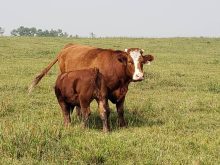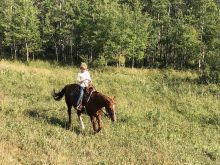The Alberta fed cattle market remains under pressure due to a buildup of market-ready cattle, larger carcass weights and seasonally low demand.
During the last week of January, Alberta packers were buying fed cattle on a dressed basis in the range of $360-$365 per hundredweight delivered. Live bids f.o.b. feedlot in southern Alberta were quoted at $217/cwt.
Alberta packers appear to have their nearby requirements covered with purchases in January scheduled for delivery in late February or early March. U.S. and Canadian beef demand typically experiences a month-over-month decline of 10 per cent from December to January.
Read Also

Gentle treatments for pain in the neck
Heading toward year-end, people unknowingly tense up against the cold and busyness, causing neck pain that can often be treated with appropriate support and gentle mobility, athletic therapist Kathlyn Hossack says.
Consumption behaviour tends to remain at lower levels through February before increasing in March and April.
Alberta fed cattle basis levels are historically wide, with Alberta cash values C$21/cwt. below the February live cattle futures converted to Canadian currency.
The nearby feeder market has divorced from the fed cattle complex due to tighter feeder supplies on both sides of the border.
At the time of writing this article, medium- to larger-frame mixed steers weighing 950 pounds were quoted at $285/cwt. in central Alberta. Angus-based calves averaging 500 lbs. were valued at $415/cwt. in the same region.
U.S. cattle on feed inventories have been running two per cent above year-ago levels throughout the fall and winter. During September through November, the U.S. slaughter was lower than anticipated and feedlots realized a building of market-ready fed cattle supplies.
The slaughter pace increased in December, then started to ease again in January. U.S. carcass weights are up about 20 lbs. from last year. Placement data through the fall and winter suggest market-ready fed cattle supplies are similar to year-ago levels.
However, the year-over-year decline in the slaughter pace has caused fed cattle supplies to build. Cattle on feed 150 days and over are above year-ago levels. The backlog of market-ready cattle has been enhanced by feedlots’ unwillingness to sell at the current levels.
Red ink
A similar market environment has developed in Western Canada.
Alberta and Saskatchewan feedlot placements from August through December 2023 were 1.095 million head, up 3,000 head from the same period of 2022. Cattle-on-feed numbers in the two main provinces have been hovering one to two per cent above last year’s levels.
Weekly slaughter and fed cattle exports, however, have been hovering below year-ago levels. Alberta feeding margins are deep in red ink on unhedged cattle.
Looking forward, the backlog of market-ready fed cattle supplies will likely be cleaned up by the end of April on both sides of the border. At the same time, beef demand tends to make its seasonal high during April and May. The Canadian economy is experiencing recessionary behaviour. Highly indebted consumers are pulling in the reins on spending. Higher interest rates are taking a bite of disposable income.
The U.S. economy is faring better than expected, with equity markets trading near historical highs. U.S. consumer spending has been stronger than expected. Although restaurant traffic is down by eight to 10 per cent from last year, away-from-home food spending continues to come in nine per cent to 11 per cent above last year. U.S. at-home food spending is only up one per cent from year-ago levels.
The U.S. Department of Agriculture’s Jan. 1 cattle inventory report was considered bullish for the feeder complex. U.S. cow-calf producers continued to contract the herd during 2023. Beef cows and heifers that have calved as of Jan. 1, 2024 totaled 28.2 million head, down two per cent or 716,000 head from the Jan. 1, 2023 number of 28.9 million head. This is considered a historical low. Heifers for beef cow replacement on Jan. 1, 2024 were 4.858 million head, down one per cent or 71,300 head from Jan. 1, 2023. The 2023 calf crop came in at 33.593 million head. This was down 846,500 head from the 2022 calf crop of 34.44 million.
Notice in the table here that 2024 U.S. third-quarter beef production is expected to be down 180 million lbs. from the third quarter of 2023.

A year-over-year production decrease of 500 million lbs. is expected during the fourth quarter. This is driving the market higher for feeders under 700 lbs. We’re expecting yearlings and calves to trade at fresh historical highs during August and September 2024.
















